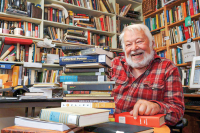Setting the stage: Wave plus water equals ideal freestyle paddling venue
 The steep-walled gorge of Nantahala River may be one of the best spots to host a world class, extreme kayak competition — at least that’s what the organizers of the upcoming 2012 International Canoe Federation Freestyle World Cup final are hoping.
The steep-walled gorge of Nantahala River may be one of the best spots to host a world class, extreme kayak competition — at least that’s what the organizers of the upcoming 2012 International Canoe Federation Freestyle World Cup final are hoping.
The competition, slated for Sep. 7-9 in front of the Nantahala Outdoor Center, will feature over more than freestyle kayaking, squirt-boating and canoeing athletes from more than a dozen countries, including Australia, Costa Rica, Slovakia, Japan and Russia. But the secret to making the river a churning pool of boat acrobatics and assorted water moves is hidden beneath the surface.
An underwater apparatus installed in the riverbed creates a 12-foot-wide artificial wave that makes all the tricks possible. Water rushes over a series of giant concrete blocks that kicks up a type of standing wave coveted by these freestyle athletes. The paddlers can plunge their boats in, on top, underneath and around the wave, channeling its current to help them flip, spin, turn, do cartwheels and everything in between.
Waves can occur naturally, thanks to rock formations and boulders in the riverbed but usually are tucked back into the woods. Waves are also built into artificial, man-made whitewater parks. Organizers of the World Cup event say they can promise a spectator friendly blending of the natural and the artificial at the NOC.
“This river here is something in between,” said Zuzana Vanha, events manager at the NOC and a one of the organizers for the cup.
Related Items
Vanha said the problem with a natural wave feature — although the surroundings can be pristine and fitting for an outdoors event like kayaking — is that the wave can be unpredictable due to a shifting river bottom or in a remote location, difficult to reach for fans and without amenities that spectators enjoy, like nearby lodging, restaurants and parking.
Building the wave was a $300,000 project funded by a combination of local tourism dollars and a state economic development grant. Completed last winter with an eye toward the world competitions, it is only one of a handful of custom-built wave shapers on a natural river in the U.S.
 But, the artificial wave is not the only aspect that sets the Nantahala River apart from its counterparts. The other feature that makes the wave possible is located eight miles up stream: the dam.
But, the artificial wave is not the only aspect that sets the Nantahala River apart from its counterparts. The other feature that makes the wave possible is located eight miles up stream: the dam.
The wave feature is essentially useless, just a wall sunk in the water, without the predictable flow of water released by the hydroelectric operation up river. Like a light switch, the water turns on every day at 9 a.m. in the morning, arriving at the NOC about two hours later to raise the river to the level necessary to make the wave, and then turns off again at 5 p.m.
This predictability makes planning an event much less risky, said Charles Conner, marketing director at the NOC and member of the cup’s organizing committee. Regardless of a long, dry spell or torrential rains, the river, as well as adjustable features of the wave wall, can be manipulated to achieve optimum competition levels.
“It’d be really bad to throw a party and not have a wave,” Conner said.
And the party gets even bigger in next year. The cup event at the Nantahala River is also a prelude to the world championship freestyle competition to be held at the same location in 2013, when more athletes and thousands of spectators are expected to arrive.

Making the grade
The Freestyle World Cup coming to the Nantahala River in September will serve as a proving ground for athletes who hope to represent their countries at the even bigger event following on its heels next year: the Freestyle World Championship.
While the 2012 World Cup events have a more open field of competitors, the 2013 World Championship event consists of only the top qualifying athletes from around the world.
But, only those with the highest scores will stand out among the rest.
This type of freestyle boat competition is much akin to a gymnastics routine or snowboarding half-pipe, where athletes try to outperform each other with a series of tricks or moves within the confines of a closed course. On each run, the athlete is given 45 seconds to perform his or her routine in the standing wave before a panel of judges.
 There is a list of possible moves an athlete can perform and each move has a maximum amount of potential points to be awarded. The moves carry names like Tricky Woo, Phonics Monkey and Space Godzilla. Bonuses and multipliers are given for performing moves with only one paddle stroke or no paddle stroke. Also stringing moves together in a series improves scores.
There is a list of possible moves an athlete can perform and each move has a maximum amount of potential points to be awarded. The moves carry names like Tricky Woo, Phonics Monkey and Space Godzilla. Bonuses and multipliers are given for performing moves with only one paddle stroke or no paddle stroke. Also stringing moves together in a series improves scores.
Scores are averaged between the three judges, approved by a head judge and then displayed on the scoreboard for spectators to see. The scoreboard and touch screen computers used to track moves are a relatively new phenomenon in the sport targeted at making the judging more efficient and spectator friendly.
Competitors will work their way through elimination brackets, with the highest scores earning advancement, until only the finalists remain. The World Cup event at the Nantahala Gorge is the third and final event of the cup series. Two other events were held in Tennessee the two weekends prior, but the world champions for 2012 won’t be named until the waves are done churning in the Nantahala Gorge.
Meet the athletes
Several local athletes will be among the 100-plus paddlers from more than 15 countries descending on the Nantahala Gorge for Freestyle Paddling World Cup this September.
Scott McCleskey, 34, Sylva, freestyle canoe and freestyle squirt boat
Aleta McCleskey, 31, Sylva, freestyle kayak and freestyle squirt boat

 Scott and Aleta McCleskey met on a river, as the couple likes to describe it, when they were junior competitors training for slalom racing. They were both good enough to land spots touring around Europe as members of the United States National Canoe/Kayak Slalom Junior Team. In 1998, they moved to the area specifically to be close to the paddling training grounds of the Nantahala. They picked jobs that would allow them to live here, with Scott going into carpentry and Aleta getting her nursing degree and now working as a local emergency room nurse.
Scott and Aleta McCleskey met on a river, as the couple likes to describe it, when they were junior competitors training for slalom racing. They were both good enough to land spots touring around Europe as members of the United States National Canoe/Kayak Slalom Junior Team. In 1998, they moved to the area specifically to be close to the paddling training grounds of the Nantahala. They picked jobs that would allow them to live here, with Scott going into carpentry and Aleta getting her nursing degree and now working as a local emergency room nurse.
With the Freestyle World Cup final on the Nantahala River approaching, the pair is excited for the opportunity to be back on the world stage. Scott McCleskey has already stirred his competitive spirit and swore he was going for it all.
“I mean, who wants second?” Scott McCleskey said. “I go to every competition trying to win.”
One of the first competitive water sports he participated in was freestyle kayaking, at a time when the boats were much larger and it was called “rodeo,” she said. Later, he concentrated more heavily in slalom racing, even serving as an alternate on the U.S. Olympic Team.
Aleta McCleskey, a member of the USA National Freestyle Kayak Team in the late 1990s and early 2000s, is looking at the cup event on the Nantahala River as a chance to go up against a slew of local and international talent. She said her job doesn’t allow her to get away very frequently, so she couldn’t forego the opportunity to participate in a freestyle competition being held a short drive from her doorstep.
“Now that the event is here and close to home, I though why not go out and do some kayaking,” Aleta McCleskey said.
Matt Anger, 22, Bryson City, freestyle kayak and freestyle squirt boat
 Matt Anger has been visiting the Nantahala Outdoor Center during the summers with his family since he was a child. He was first given lessons in kayaking and whitewater sports by NOC staff and slowly expanded his interests to include freestyle kayaking. Then, at the age of 16, Anger started working at the NOC for the rafting season.
Matt Anger has been visiting the Nantahala Outdoor Center during the summers with his family since he was a child. He was first given lessons in kayaking and whitewater sports by NOC staff and slowly expanded his interests to include freestyle kayaking. Then, at the age of 16, Anger started working at the NOC for the rafting season.
“Everyday I would spend a few hours paddling before work,” Anger said. “It was great.”
Originally from Mississippi, Anger moved to Bryson City year-round about two years ago and is now attending Southwestern Community College and working with the NOC as an information technology specialist. Anger will be a competitor in the upcoming 2012 World Cup.
Recently, at a competition in Tennessee, one of two events leading up to the final cup round on the Nantahala River, Anger was able to make it to the quarterfinals while competing with elite international and national kayakers.
But, Anger said the steep competition, which included prior year’s world freestyle champions, didn’t intimidate him, it motivated him to want to train harder. He said he has set his sights even higher for the future event on his home turf.
“I’d like to place well and make quarterfinals or beyond,” Anger said. “I’m not in it to win it, but I’m shooting for the top 20.”
Maria Noakes, 45, Bryson City, freestyle kayak
 As middle-aged Maria Noakes pulled her boat out of the Nantahala River, following several freestyle kayak practice runs, she wondered if maybe she was the only competitor in the nearing Freestyle World Cup final with two children. After her run of extreme kayaking on a Thursday afternoon, she was on her way to pick them up.
As middle-aged Maria Noakes pulled her boat out of the Nantahala River, following several freestyle kayak practice runs, she wondered if maybe she was the only competitor in the nearing Freestyle World Cup final with two children. After her run of extreme kayaking on a Thursday afternoon, she was on her way to pick them up.
“I’m basically retired, but I’m coming back for this event,” Noakes said. “I’m just doing it because it’s in town.”
Noakes is originally from New Zealand, as demonstrated by her black kayaking helmet featuring the country’s emblematic silver fern. She will still represent her native country in the competition but is now more of a hometown competitor with a house and a nearby business, Smoky Mountain Jet Boats, along the Nantahala River.
Noakes, wearing the hat of an area business owner, said besides her personal participation in the event, she would like to see the influx of spectators and athletes boost the local economy a bit as well.
Noakes was once a regular in freestyle competitions and other river sports, participating in events since 1997. And with years under her belt, she noted that the sport of freestyle kayaking has evolved to consist of far more aerial moves, like flips and spins, than it used to, especially for female competitors.
“There’s no masters category,” said Noakes of the competition. “I wish there were. I have to compete with everyone. And everyone else is like 25.”
Tools of the trade
The boats
 The freestyle competition at Nantahala River Gorge will consist of several types of watercraft used by athletes to achieve tricks and other moves in the water. Although short canoes and a very small boat, called a squirt boat, are also used, the most common type of watercraft used is the freestyle kayak. It’s smaller in length than a typical recreational kayak or canoe with increased maneuverable so the watercraft is quick to react to the movements of the paddler. A freestyle kayak can be made of plastic or carbon fiber and weigh between about 20 and 30 pounds depending on the material used. Lighter weight and custom-made kayaks can cost an upwards of $2,000, while a plastic boat can cost about $900. Sometimes a lighter-weight kayak will sacrifice durability, but a matter of a few pounds can make the difference between in an elite competition, especially when bonus points are given to routines where a paddler goes airborne with the boat.
The freestyle competition at Nantahala River Gorge will consist of several types of watercraft used by athletes to achieve tricks and other moves in the water. Although short canoes and a very small boat, called a squirt boat, are also used, the most common type of watercraft used is the freestyle kayak. It’s smaller in length than a typical recreational kayak or canoe with increased maneuverable so the watercraft is quick to react to the movements of the paddler. A freestyle kayak can be made of plastic or carbon fiber and weigh between about 20 and 30 pounds depending on the material used. Lighter weight and custom-made kayaks can cost an upwards of $2,000, while a plastic boat can cost about $900. Sometimes a lighter-weight kayak will sacrifice durability, but a matter of a few pounds can make the difference between in an elite competition, especially when bonus points are given to routines where a paddler goes airborne with the boat.
The paddles
The paddle is another important aspect of freestyle competition gear. Paddles can vary in length, weight, material and price – a paddle can cost anywhere between $250 and $500. Typically, for freestyle kayak competition, a double-bladed paddle made of fiberglass or carbon fiber is used to assist an athlete in performing tricks with the boat. For canoe play boating, a one-sided paddle is used while the boater kneels in the boat. Play boating paddles tend to have a broader blade to increase the power of each paddle stroke and assist the paddler in his or her movements while river or sea kayaks tend to have more slender blades that produce less power. Although a paddle is an essential piece of equipment, a sure way to gain an edge is to forego use of the paddle during a trick for a point bonus.
Personal Gear
Apart from the paddle and boat, an athlete will use a variety of personal equipment and clothing for freestyle and play boating. Personal gear can change depending on individual taste, but an outfit is usually is comprised of a helmet, made of a hard resin or carbon fiber; a spray skirt made of neoprene and rubber, which forms a seal between the paddler and kayak to keep water out of the boat; some sort of spray jacket made of a waterproof and breathable material, which keeps the paddler’s body dry; and sometimes a life jacket, though it is generally not worn by all athletes during freestyle competition. Standard play boating gear can cost an upwards of $500 just to get started.
Come check out the World Cup
Spectators are welcome and encouraged at the Freestyle Paddling World Cup. Head south on U.S. 74 past Bryson City and into the Nantahala Gorge on any of the event days, and you can’t miss the action. For more information, www.freestylekayaking2013.com.
• Friday Sep. 7, 10 a.m. to 7 p.m. Men’s kayaking in the morning and squirt-boating, canoeing and junior heats in the evening
• Saturday, Sep. 8, 10 a.m. to 6 p.m. Canoeing, women’s kayaking and men’s kayaking quarterfinals in the morning and semi-finals for all events in the evening.
• Sunday, Sep. 9, 10 a.m. to 4 p.m. Finals for all events throughout the day with women’s and men’s kayaking finals scheduled as the last events of the day.









